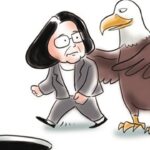The Trump administration has imposed new tariffs on Chinese twist-ties, the Wall Street Journal reported on Thursday, in a worrying sign that the US-China economic conflict may be rekindled.
While the move’s impact is relatively limited, it actually does not bode well for the two countries, possibly reigniting their past and controversial dispute and fight on currency value.
This is because the US justified the new-tariff decision with claims that China undervalued its currency in order to gain market share for Chinese-made products, a familiar accusation the world has heard of before. This latest allegation of currency manipulation is expected to set a bad precedent for US companies facing rising competition with imported products.
Apparently, what has struck the world is that the tariff decision by the Trump administration is made at a time when the Chinese yuan has steadily strengthened for nearly five months now. On Thursday, the central parity rate of the yuan against the US dollar reached 6.5780, representing a sustained broad rally compared with the market level in May.
And with the COVID-19 epidemic largely put under control, the rapid recovery of the Chinese economy and the country’s resilient export performance, the appreciation of the yuan is fully in line with market expectations. Under such circumstances, the imposition of the new punitive tariffs on the allegation that China’s currency is undervalued sounds particularly absurd and ridiculous.
In fact, observers watching China’s exchange rate policy and its financial system reform and upgrade, would not believe that Chinese government would want to pursue a weak yuan. This is because even though depreciation of the Chinese currency may be conducive to exports, it could actually do more harm than good to the overall Chinese economy by delivering a blow to market confidence which is significant for its money market stability at a time of growing global uncertainties.
Maintaining a stable and steady yuan exchange rate with the world’s major currencies will be the long-term goal for China’s macro-economic regulators.
The yuan’s exchange rate used to be a bone of contention throughout US-China economic and trade relations. They turned the page when signing the phase one trade deal earlier this year that stipulates that “each party shall respect the other party’s autonomy in monetary policy, in accordance with the domestic law.”
In this sense, the latest tariff imposition on twist-ties by the Trump administration reflects a sinister intention to create more traps for the incoming Joe Biden administration which is most likely to reset severely fraught ties with China in the past four years. Trump’s resort to leaving the sordid political legacy before his term comes to an end, may put Biden administration’s relationship with a crucial trade partner under pressure. For the benefit of both countries, we hope Biden’s team could extend a friendly hand and re-engage with China, constructively.
Global Times



